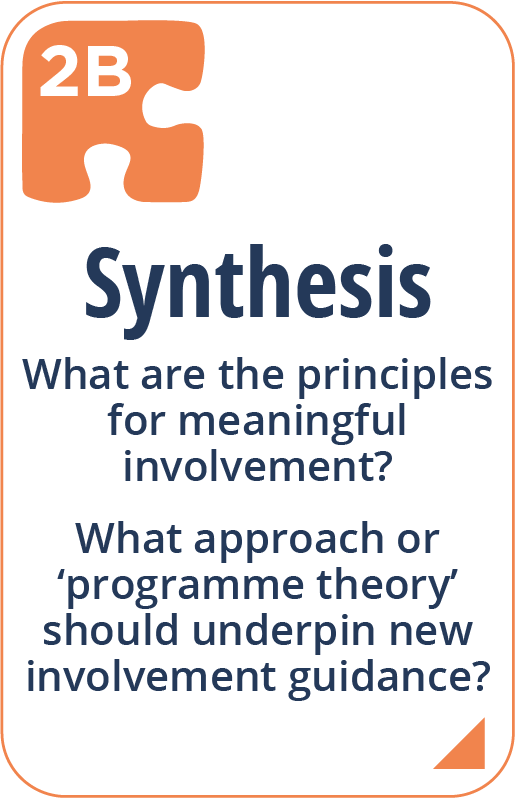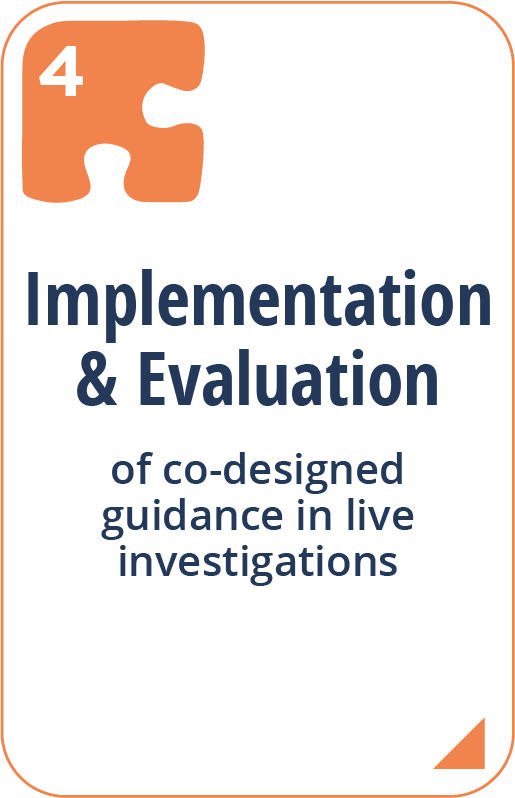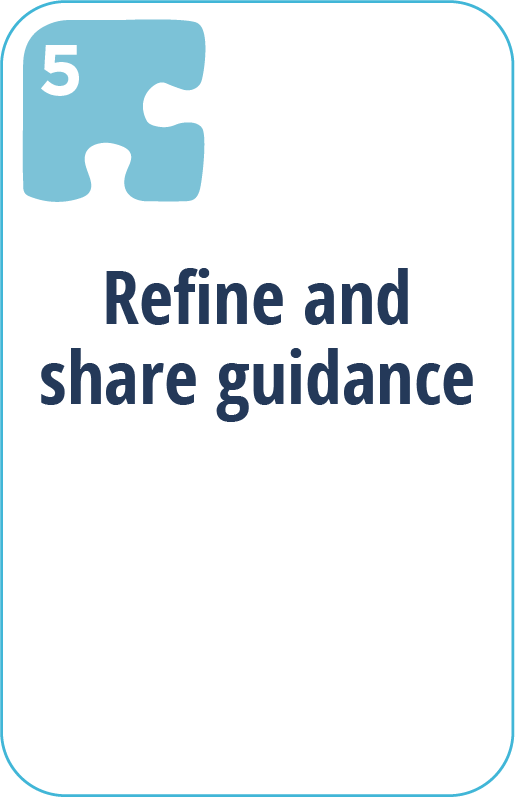Background evidence
The Learn Together resources were based on evidence generated from an independent research programme (the Learn Together programme), funded by the National Institute for Health and Social Care Research, which began in October 2019. You can find out more about each stage of the research programme, and the outputs below.
Overall, we found that incident investigations are complex, relational processes, that have the potential to either repair, or compound the harms from patient safety incidents. Our co-designed processes are feasible and acceptable, and support more comprehensive and systematic involvement of patients and families in investigations, and the learning that arises from them. Importantly, they might support the reduction in the significant and long-lasting effects of compounded harm for patients and families, although our study design cannot establish this. Investigations are complicated by divergences in the needs of different stakeholders involved in investigations, often relating to their purpose and focus. Navigating this complexity requires skilled, well-supported investigators, who work with an organisational infrastructure flexible enough to allow them to individualise their approach.

Stage 1: Literature review and documentary analysis
Months 1 – 15 (October 2019 – December 2020)
What we did:
1A) Literature Review
First, a scoping review of the qualitative literature explored the experiences of patients and families within incident investigations, and what prompts decisions to litigate. Three databases were searched, followed by independent screening of title and abstracts (20% double screened). Data were extracted from included studies, before undergoing a narrative synthesis.
1B) Documentary Analysis
Second, we conducted a documentary analysis of policy documents referring to the involvement of patients/families in incident investigations. A random sample of 103 NHS trusts (50% of all trusts in England) were approached, supplemented with searching trust websites. A total of 43 documents were sourced, and submitted to a qualitative documentary analysis, with particular attention to how involvement of patients, families and staff was described, and how this was presented in the context of the whole document.
What we found:
From identifying these sources of information, we synthesised the common themes across the literature. Our literature review found that most patients and families valued being involved; however, it was important that investigations were flexible and sensitive to both clinical and emotional aspects of care to avoid compounding harm. This included the following: early active listening with empathy for trauma, sincere and timely apology, fostering trust and transparency, making realistic timelines clear, and establishing effective non-adversarial communication. Most staff perceived that patient and family involvement could improve investigation quality, promote an open culture, and help ensure future safety. However, it was made difficult when multidisciplinary input was absent, workload and staff turnover were high, training and support needs were unmet, and fears surrounded litigation. Potential solutions included enhancing the clarity of roles and responsibilities, adequately training staff, and providing long and short-term support to stakeholders. Our review provides insights to ensure patient and family involvement in serious incident investigations considers both clinical and emotional aspects of care, is meaningful for all key stakeholders, and avoids compounding harm. However, significant gaps in the literature remain. You can access the paper relating to the literature review here.
Evidence from across these two studies suggests that all stakeholders value patient and family involvement in incident investigations, but that this is not facilitated or supported by local policy. Staff found involvement easier when guided by clear policy and systematic processes, that can be flexibly applied. If patients and families felt involved, they were less likely to pursue litigation. You can access the paper relating to the documentary analysis here.
Stage 2: Interviews and Synthesis of Findings
Months 1-15 (October 2019 – December 2020)
Here we wanted to:
- To understand the context within which processes for supporting great involvement in serious incident investigations would operate.
- To develop the programme theory that would underpin the co-designed investigation resources.
What we did:
2A) Interviews
A qualitative semi-structured interview study was conducted with patients/families, healthcare staff, legal staff, and investigators. We invited participants via i) communication from partner sites; ii) charitable organisations; iii) social media; iv) snowball sampling. 117 people registered interest and 42 participated (18 patients/families; 7 staff; 16 investigators; 1 legal representative). Data were analysed using an inductive reflexive thematic approach.
2B) Synthesis
A three-phase analysis and synthesis was conducted on data from stages 1 and 2A. The inductive analysis phase involved creating short descriptive reports for each of the previous three studies. An abductive analysis phase based on three foundational theories and approaches, created a new analytical framework to support the development of the draft common principles and narrative programme theory. A synthesis phase ran parallel with the first two, bringing them together through a series of analytical workshops.
What we found:
Patients and families reported starting an investigation with cautious hope, before realising that they lacked power, knowledge, and support to navigate the system. For some, this ultimately resulted in feeling compelled to pursue litigation. Staff experienced similar injustices such as exclusion and lack of support. All stakeholders need help understanding what an investigation is, system navigation assistance, and tailored short- and longer-term support. Investigating was also found to be skilled ‘work’ requiring adequate training, resources, and infrastructure support to balance competing priorities.
We then developed ten common principles for meaningful involvement. The juxtaposition of existing theories illuminated new insights. First, that organisational learning is not the only desired outcome for incident investigations, with patients and families (and sometimes staff) reporting the need for restoration and repair. Second, investigations can be part of reparation, but when they fail to address the needs of stakeholders arising from investigations, it can compound the harm of the original incident. Our programme theory further developed these insights, to propose how guidance and processes might better support involvement and reduce compounded harm.
Multiple papers are currently being written up for publication in relation to the interview study.
Stage 3: Co-design
Months 19 – 24 (April – September 2021)
Our two goals for this stage were:
- To iterate and agree the common principles for involvement.
- To co-design three parallel processes for guiding patient and family involvement in mental healthcare, acute care and national level serious incident investigations, reflecting the common principles.
What we did:
We conducted a longitudinal, largely remote co-design process, informed by the UK Design Council Double Diamond for Innovation. Co-design activities comprised two large stakeholder events bookended by a series of three co-design workshops that ran in three parallel workstreams, reflecting (i) acute settings, (ii) mental healthcare settings, and (iii) national independent investigatory body setting. A ‘co-design community’ of >50 stakeholders was formed, with members invited to participate in all activities. A range of innovative co-design activities were used, to build relationships and trust, and support generation of ideas.
What we found:
The co-design phase had two main outputs. First, we collectively co-designed new guidance, underpinned by the common principles and programme theory, to support investigators to involve patients and families in incident investigations, in ways that may reduce compounded harm. Second, we developed a community of co-design partners that not only supported generation of new guidance, but also further iterations in Stage 5, and provided credibility for, and dissemination of, the final programme outputs.
Copies of these can be downloaded here.
The Learn Together investigation resources has been incorporated into NHS England and Improvement’s national policy for involvement within the new Patient Safety Incident Response Framework. A paper relating to this phase of the programme is currently being written up.
Stage 4: Implementation and evaluation of co-designed guidance in live investigations
Months 25 – 42 (October 2021 – March 2023)
What we did:
This aim of this stage were to:
- Determine if they are feasible and acceptable to patients, families, healthcare staff and investigators.
- Understand if, and how, they influence learning, recommendations, action plans and decisions to litigate.
A 15-month focused ethnography was conducted across four NHS trusts, and within maternity investigations undertaken by the national investigatory body. We trained 49 investigators in the new guidance, before working with 16 investigators within 29 real-time investigations. We undertook 127 remote qualitative interviews (92 semi-structured, recorded interviews, and 35 ethnographic interviews) at different investigation touchpoints, with investigators, patients/families, and staff. 44.5 hours of non-participant observation was undertaken, including investigator training, and site-based meetings. Analysis proceeded using an inductive approach. First, an adapted version of pen portrait methodology brought together all data into individual cases at the level of the investigation, along with contextual organisational summaries. Following this, we conducted a multi-case analysis using a reflexive thematic approach, with the investigation case as the unit of analysis, in conjunction with the organisational summaries.
What we found:
Stakeholders were almost universally positive about meaningful patient and family involvement, and generally agreed that it could aid organisational learning. The co-designed guidance supported systematisation of involvement, as well as encouraging the relational element, with a key enabler being the rollout of the PSIRF. There is a need for formal recognition and support for the complex challenges different stakeholders face as they navigate the system procedurally, relationally, and emotionally. Organisational infrastructure needs to be aligned to support investigators to meet the multiple needs of investigations, and the stakeholders involved in them.
Stage 5: Refine and share guidance
Months 42 – 48 (March – Sept 2023)
What we did:
Following the ethnography, a series of four final workshops were convened with co-design partners and other stakeholders, to discuss findings, and agree required iterations to the final guidance.
What we found:
Our revised guidance was reorganized around the ‘Five-Stage Process’, which centres the needs of patients and families to be heard and their experiences dignified at the start of the investigation, followed by flexibility in involvement throughout.
Additional funding:
We also received additional funding for a qualitative study combining interviews and a qualitative free-text survey. Semi-structured interviews were conducted with staff, managers and policymakers with experience of investigations following suicide. Purposive sampling was employed, with recruitment undertaken via social media, and approaching policymakers directly. A fully qualitative survey was developed to explore the experience of those bereaved by suicide, of the investigation and other processes that follow. The survey was based on the stage 2 findings, and further developed with a family representative. The survey was distributed via social media, charities relating to suicide, and the Care Quality Commission. Data were combined and analysed using reflexive thematic analysis.
Fourteen interviews were conducted, and 18 survey responses were received. Seven themes were generated. Investigations were found to have both explicit and implicit purposes, causing confusion, and limiting their effectiveness in achieving learning and improvement, and supporting families. Suicide was largely regarded as different to other safety events, due to variability in treatment and care standards, the ability to control risk, and distribution of care across settings and time. What constitutes meaningful involvement was both similar to that in the wider programme, but different, in part due to the fact that people who die by suicide may have a long history of receiving care, and the complexity of familial dynamics. Investigations need to decouple learning from the provision of postvention support. However, even once decoupled, we suggest that the needs of families might always be at odds with the organisational driver of learning and improvement as the principal aim of investigations.
A paper relating to this stage of the work is currently being written up.

















